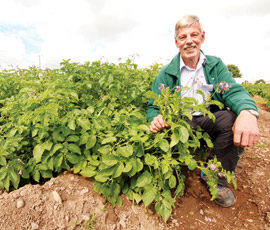Tips on breaking the potato blackleg cycle

The dry summer has pushed blackleg down to its lowest levels in recent years and so potato growers are being urged to focus on best practice to ensure it stays that way.
Caused by the bacteria Pectobacterium atrosepticum (Pba), blackleg is a largely seed-borne disease that has been on the rise over the past few years.
The main source of infection is rotting mother tubers within the ridge, with the bacteria moving through the plant and soil to infect daughter tubers.
Signs of the disease in Scottish seed crops are minimal this year, creating a chance for the industry to get on top of the disease over the remainder of this season and the beginning of next.
Scottish Rural College (SRUC) potato consultant Stuart Wale said although the disease has been present this year, soils with a moisture deficit have stopped its spread.
“Last year we had saturated soils for the whole summer, meaning that the bacteria could spread easily within crops, but that hasn’t been the case this season,” he says.
Pre-basic seed crops, grown to multiply potato varieties for commercial production, are also subject to infection by wind-borne aerosols – tiny droplets of water containing Pba.
“That is the other main source of infection and the dry growing period has again minimised the spread from crop to crop this year,” added Dr Wale at a recent Potatoes In Practice event near Dundee.
Blackleg busting tips
- Harvest crops early
- Kill haulm quickly and efficiently
- Pulverise in dry condition
- Cool and ventilate seed immediately
- Store seen in correct conditions
It has been suggested that infection from stem rots – the rotten, black stems from which the disease gets its name – are also an important source of tuber infection in growing crops.
However, Dr Wale pointed out that there is little data to back that theory and even in a high blackleg year, there is not necessarily high contamination of the daughter tubers.
“If roguing plants showing symptoms, it is not necessarily freeing the crop of the disease as late mother tuber breakdown can still infect the crop,” he added.
So what can be done this year to ensure the blackleg cycle is broken?
Early harvesting is something that has been very difficult to achieve in the past two wet seasons, but is something that growers should attempt if the weather remains kind.
This will minimise any infection from aerosols and late mother tuber breakdown and even if conditions at harvest are good, Dr Wale warns that growers must quickly cool and ventilate crops soon after harvest.
He also identifies the period between the grading of the seed and the time it reaches the end users’ farms as a weak link.
Often seed is sat waiting in bulk bags in ambient stores without ventilation, creating ideal conditions for Pba to spread from infected seed tubers.
“I plea for better communication between seed merchants, handlers and buyers to ensure the seed is being kept in the correct conditions throughout the chain,” said Mr Wale.
| Pulverisation vs Desiccation |
|---|
| Potato Council funded research has shown that there is marginal difference between the mechanical pulverisation and chemical desiccation methods when assessing Pba contamination of daughter tubers.
Stuart Wale pointed out that although there was a chance of Pba spread downwind of pulverisation; it remained a perfectly acceptable means of killing the crop. “If you are going to pulverise, do it in dry conditions, which will also reduce any theoretical risk of the disease being drawn down the exposed stem,” he said. As the season brings the chance to break the blackleg cycle, haulm destruction is a key factor in achieving that and growers should ensure a quick and efficient kill, whichever method is used. Scottish Agronomy potato specialist Eric Anderson said flailing should be preceded by a diquat application five-to-seven days before to minimise bruising and vascular staining. He also advised growers to go back to basics for desiccant application, with trend towards wider sprayers and faster forward speeds making it difficult to maintain correct boom height and increasing drift. “For the first diquat application, slow down to 6km/h and use a higher water rate of 400l/ha with angled nozzles 50cm above the target to ensure good crop penetration,” said Mr Anderson. Mr Anderson favours 1.5l/ha of diquat at T1 unless soil conditions are dry, in which case the diquat rate should be dropped to 1l/ha. This should be followed by 2.5l/ha diquat at T2 and 0.6l/ha of Spotlight Plus (carfentrazone) for the T3 spray, as it is stronger than diquat on stem kill. “Keep spray intervals at no less than five days, but no more than seven,” he concluded. |

